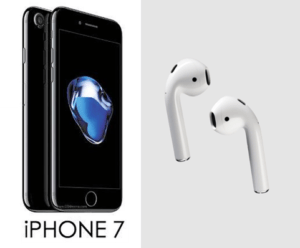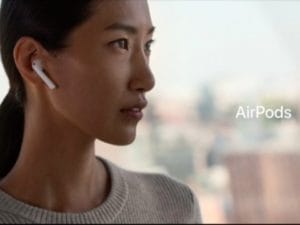Bluetooth Shortcomings
 Bluetooth Shortcomings: a reader asks…
Bluetooth Shortcomings: a reader asks…
I just got my iPhone 7 and am anxiously awaiting the release of AirPods so I can go wireless. Till then I’m using the EarPods with Lightning cable the iPhone shipped with. Can you tell me what to expect using wireless earbuds with my iPhone?
Let’s get our expectations set correctly up-front – don’t expect perfection. While I expect the Airpods to have good connectivity and reasonably clear audio (both incoming and outgoing, but don’t expect audiophile quality), there are some inherent shortcomings in Bluetooth technology that may cause some problems.
The primary issue I see is interference – that Bluetooth has difficulty when the signal is blocked, especially by a water-bearing source (e.g., your body). Anytime there is not a straight line (nothing but air) between your iPhone and the earbuds, there’s a good chance that your connection will drop out. So many of us keep our iPhones in the front or back pockets of our pants, and it’s easy for any body part to get in-between that straight line. For example, turn your head to the right and your right earbud will be blocked by your body from the iPhone in your pants pocket even if you’re thin because the trunk of your body is interposed.
The best way to mitigate this is to keep your iPhone in a shirt or jacket pocket, but that might not always be practical. It remains to be seen exactly how sensitive AirPods are to this kind of interference. Disclaimer, I’ve been testing several wireless earbuds and have found that even moving your arm in-between the iPhone and earbud can cause the sound to drop out. I’ve found pretty good results by keeping my iPhone in the right-side pocket of a hoodie or jacket with my Dash in-ear Bluetooth headphones ($300 from Bragi.com).
 The second issue is one of latency. This is primarily going to be noticeable when you’re watching a video on your iPhone. With many cheaper Bluetooth earbuds, watching a video is annoying because the audio always seems to lag just a tad from the video. That’s the latency effect, where the video and audio signals aren’t matched up – often the audio arrives just a bit later than the video signal. Sometimes that can be comical, like watching a dubbed movie. I’ve even seen it reversed, where the audio comes in front of the video. Try lip-reading and you’ll see how annoying this can become!
The second issue is one of latency. This is primarily going to be noticeable when you’re watching a video on your iPhone. With many cheaper Bluetooth earbuds, watching a video is annoying because the audio always seems to lag just a tad from the video. That’s the latency effect, where the video and audio signals aren’t matched up – often the audio arrives just a bit later than the video signal. Sometimes that can be comical, like watching a dubbed movie. I’ve even seen it reversed, where the audio comes in front of the video. Try lip-reading and you’ll see how annoying this can become!
The third issue is going to be one of battery. The earbuds are so small, that current battery technology can’t give you all-day performance. The AirPods are supposed to give you 5 hours of use (and you can recharge them several times in the case before you have to plug in), and that can get in the way. Think of being on an important call and suddenly your boss drops out – you panic, then realize the AirPods ran out of juice and you have to bring the iPhone back up to keep talking. Since there’s no simple battery indicator on the AirPods themselves, you have to either Ask Siri “How’s the battery on my AirPods?”, or hold the Airpods up next to your iPhone.
 The last issue is still unknown – your voice quality on phone calls. I’m hoping you’ll get voice quality as good or better than the microphone on your wired EarPods. But I won’t know until the AirPods are released and we see some real-world experience. The reason for my hope is that the AirPods have these shafts that extend down towards your mouth, like a boom microphone. The microphones are at the end of these shafts, and there are two of them. They also use ‘beam-forming’ technology which should help with voice clarity.
The last issue is still unknown – your voice quality on phone calls. I’m hoping you’ll get voice quality as good or better than the microphone on your wired EarPods. But I won’t know until the AirPods are released and we see some real-world experience. The reason for my hope is that the AirPods have these shafts that extend down towards your mouth, like a boom microphone. The microphones are at the end of these shafts, and there are two of them. They also use ‘beam-forming’ technology which should help with voice clarity.
I can usually tell when someone is using EarPods calling me because the voice quality is usually a little worse than when they have the iPhone (or any smartphone) to their ear. That’s simply due to the distance from microphone and your lips. Since the EarPods are a good 5″ or more away from your lips, it can be harder for someone to hear you. I often see folks with EarPods holding the microphone/switch up to their lips to get better voice quality. Since the AirPods’ microphones will be just a few inches from your lips, you should get better quality. Also since there are two microphones instead of one. Unfortunately, there’s no noise-cancellation in the initial version of AirPods, so it will be harder for you to use these in noisy environments.
So long as you’re aware of these issues and don’t consider any to be a show-stopper, by all means you should switch to the AirPods as soon as they become available. But if you want really clear and pristine music (audio quality) and don’t want to deal with the occasional drop-out caused by interference, then you should stick with wired earbuds. The EarPods that came with your iPhone provide decent audio, but if you want something better, then consider some of the great wired earbuds including Apple’s own Beats ($150) or Bose QuietComfort 20 ($250, noise-cancelling!). I have a pair of the Bose and they are the best at noise-cancelling, but the audio quality is just a step down from their SoundTrue Ultra in-ear headphones ($130 at Bose.com).
This website runs on a patronage model. If you find my answers of value, please consider supporting me by sending any dollar amount via:
or by mailing a check/cash to PosiTek.net LLC 1934 Old Gallows Road, Suite 350, Tysons Corner VA 22182. I am not a non-profit, but your support helps me to continue delivering advice and consumer technology support to the public. Thanks!






